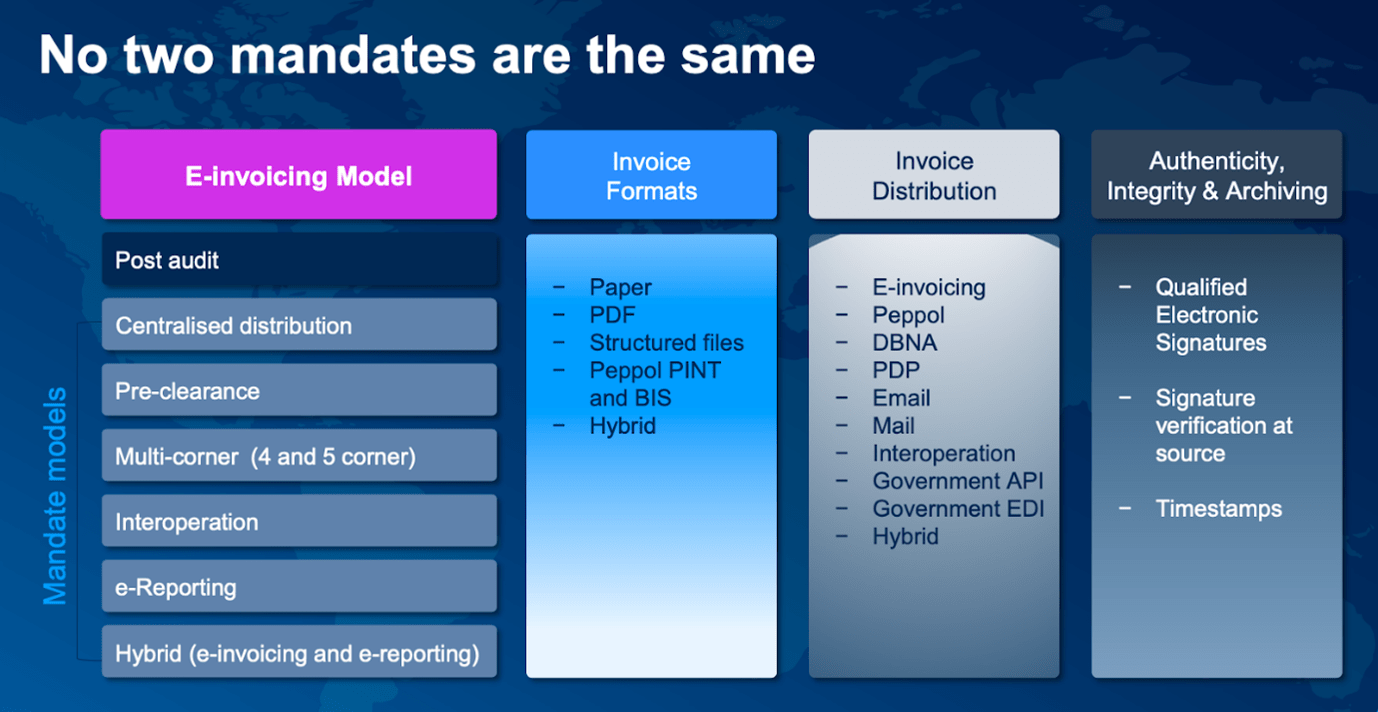If you’re a business owner in Europe, or operating globally, you’ve likely encountered a slew of new e-invoicing mandates and digital reporting requirements. These EU mandates mark a sea change in how we interact with tax authorities and manage our financial data.
That is to say, governments are now coming directly into the financial supply chain, and taking a keen interest in every invoice exchanged between suppliers and buyers. Compliance is no longer a periodic task; it's now conducted in real-time, and authorities will soon have more insight into your transactions than perhaps you do yourselves.
What's more, every country is moving at its own pace when it comes to introducing nation-specific rule changes, acceptable invoicing formats, and implementation deadlines.
All this creates a complex maze of requirements that can be overwhelming for your internal teams to navigate alone — leaving you at risk of falling behind or making costly mistakes.
To stay ahead, you need the right strategies, technology, and compliance partners. This blog will run through the key challenges of ViDA (VAT in the Digital Age) and explain how Tungsten Automation, in partnership with Sovos, can help you automate and stay ahead of the compliance curve. Read on to learn more.
What is ViDA and how will it impact businesses?
VAT in the Digital Age is the European Union’s VAT reform package, which seeks to modernize taxes (especially in the view of the challenges posed by the Platform economy), support digitization of the EU economies and increase resilience to VAT Fraud by reforming important elements of VAT in EU. The ViDA package consists of three parts (also referred to as ‘Pillars’): (i) Digital Reporting Requirements (DRR), (ii) Platform economy, and (iii) Single VAT Registration (SVR):
- Digital Reporting Requirements (DRR): Clarifies that, by 2030, all cross-border, intra-EU invoices must be reported electronically to the national tax authorities in (near) real-time. De facto this means that invoices between EU member states must be electronic. Each national tax authority will then aggregate the data into a centralized EU database (extended VIES) to maintain data consistency, increase financial visibility, and combat fraud.
- Platform Economy: Outlines specific VAT obligations for digital platforms that facilitate the sale of goods and services, such as Airbnb and Uber.
- Single VAT Registration (SVR): This pillar expands the use of the One-Stop Shop (OSS) framework, enabling businesses to register for VAT in a single member state and manage compliance for transactions across multiple EU jurisdictions.
Per Forbes, it is expected that these actions are expected to bring in between EUR 172 billion and EUR 214 billion net benefits over a 10-year period, including EUR 51 billion in savings for businesses.
The DRR requirements are expected to be the most impactful to EU businesses. And while no EU member state has fully implemented ViDA yet, some countries, such as France, Belgium, Croatia and Germany, are now introducing their own national e-invoicing mandates, to pre-align with ViDA. Other countries, like Italy and Poland will need to retroactively harmonize their e-invoicing models with ViDA by 2035. Many more EU member states are expected to implement local e-invoicing requirements and harmonize these with the larger EU-wide mandate over the next couple of years. EU Businesses should prepare themselves (or even brace themselves) for significant changes over an extended period of time as national tax offices are aligning their local VAT systems with the requirements of ViDA.
Challenges in Adapting to New Tax Regulations
Major tax changes often cause confusion and disruption to businesses — even when sufficient notice is given — because adapting to new processes, no matter how well-resourced your finance team may be, always brings challenges. In the case of ViDA, organizations across all industries will need to adapt to the following paradigm shifts:
Dependent to Omniscient
Previously, governments relied on businesses to self-assess and report their tax liabilities; making the system dependent on what companies disclosed. Now, authorities are monitoring transaction data in real-time, which provides them with insights and instruments they did not have before, ranging from immediate identification of suspicious transactions that trigger spot audits, to prefilled tax returns. This new level of government omniscience means that you must maintain complete transaction visibility; mirroring exactly what tax authorities see, as well as put processes in place to potentially challenge inaccuracies if pre-filled information is incorrect.
Risk Management to Non-Existence
The traditional approach of weighing the likelihood and magnitude of compliance risks to decide how strictly to follow regulations is now obsolete. In the new ‘real time VAT’ environment, noncompliance is synonymous with nonexistence, as you must ensure full compliance in real-time or risk operational delays, disruptions, as well as fines from regulators.
Post-Audit to Clearance
ViDA is driving a fast shift towards local implementations of Continuous Transaction Controls (CTC) in EU member states, where governments can monitor transactions in real time, or even before these are shared with the recipient. But, as all cross-border businesses know, no two mandates are the same. There are significant variations in invoicing models, acceptable formats, distribution methods, and how each government chooses to authenticate invoices (see illustration below).

This means that if you get a detail wrong, your transaction could be blocked on the spot, making it critical for you to manage the whole gamut of compliance requirements across every market in which you operate.
Stability to Volatility
Where you once faced only a handful of regulatory updates each year, your business must now prepare for the simultaneous rollout of e-invoicing mandates in up to 27 EU countries by 2030. This unprecedented wave of change means you must be agile enough to adapt quickly – even as individual countries revise their rules at the last minute. Change is no longer something that happens from time to time: it is the new status quo, and companies must adopt a permanent change mindset to endure. The era of gradual tax compliance has given way to ongoing volatility, and this necessitates constant preparedness as a result.
Many businesses try to manage tax compliance in-house or rely on a single vendor for everything, but this approach will become increasingly unsustainable in the years ahead.
As we explored in our recent Where ViDA is Heading webinar, the tax landscape is simply too complex and specialized for any one provider or internal team to manage alone. The more compliance drains your resources, the harder it is to stay competitive and responsive. Therefore, to maintain your competitive edge, you need solutions that ensure both effective compliance and streamlined processes across all markets.
ViDA Compliance Solution: Tungsten Automation in Partnership with Sovos
Tungsten Automation and Sovos have joined forces to offer a harmonized, best-in-class solution for businesses facing e-invoicing implementation challenges.
|
Our end-to-end invoicing platform, InvoiceAgility, is built to handle any invoice, in any format, from any country — fully automating your Accounts Payable (AP) and Accounts Receivable (AR) processes.
Meanwhile, Sovos brings global expertise across the whole compliance spectrum — including CTC, tax determination, regulatory filing, SAF-T, eAccounting and analytics — to ensure you can manage all of these areas in a coordinated way.
Together, we deliver every aspect of invoice automation and compliance in a single, integrated solution; giving your business complete ViDA coverage and future-proofed systems.
Join me on our upcoming webinar on November 20th to learn more.
|

|
ViDA Readiness Partnership Benefits
- Universal Standards and Formats: InvoiceAgility supports all major structured invoice formats, including UBL 2.1, Peppol BIS, and hybrid standards such as ZUGFeRD, with full compliance to the European Norm (EN 16931).
- Cross-Border Reporting: Be ready for (near) real-time reporting of cross-border B2B invoices with existing connections to tax authorities in Italy, Romania, Poland, and France.
- System Interoperability: Our platform serves as a Peppol Access Point for both inbound and outbound invoices, and InvoiceAgility interoperates with over 70 European service providers. Moreover, Tungsten Automation fully underwrites the GENA Model Interoperation (Framework) Agreement (MI(F)A) to ensure ongoing interoperability with ViDA.
- One Platform, Global Reach: InvoiceAgility ensures you can automate ViDA cross-border and domestic compliance (covering France, Poland, Romania, Slovakia, Spain, Italy, Denmark, the UK, and more) through a single solution, eliminating the need for separate, localized solutions.
- Certified and Auditable: The Tungsten e-Invoicing Network is ISO 27001 certified and complies with numerous local and international e-invoice obligations across global markets, including Malaysia, Mexico, Australia, and others.
Turn Tax Compliance into a Competitive Advantage with Tungsten Automation
E-invoicing is here to stay, so preparing for ViDA is vital. That said, regulatory demands shouldn’t consume all the time and energy your finance team needs to drive your core business forward. With the right partners, you can turn compliance from a burden into a source of efficiency and proactive financial management.
Let Tungsten Automation and Sovos handle the complexity for you, so you can run your business with confidence, knowing your invoice automation processes will always remain compliant and future-ready.
If you would like to find out more, get in touch with us now to talk to one of our e-Invoicing experts.







